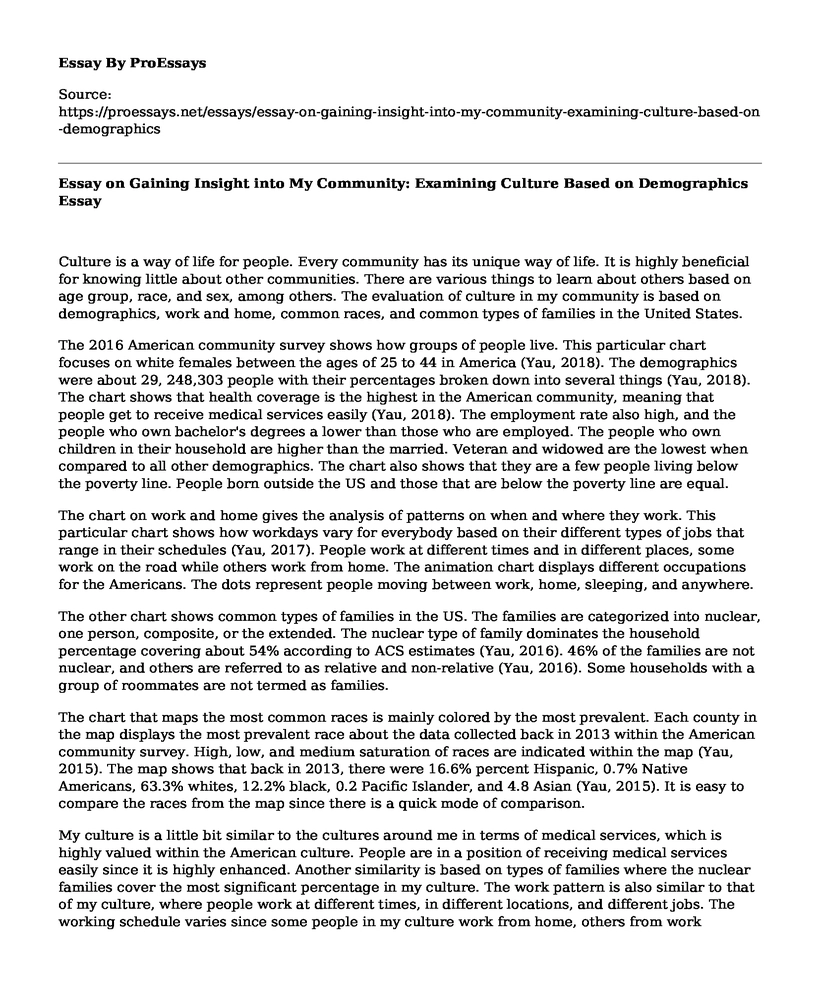Culture is a way of life for people. Every community has its unique way of life. It is highly beneficial for knowing little about other communities. There are various things to learn about others based on age group, race, and sex, among others. The evaluation of culture in my community is based on demographics, work and home, common races, and common types of families in the United States.
The 2016 American community survey shows how groups of people live. This particular chart focuses on white females between the ages of 25 to 44 in America (Yau, 2018). The demographics were about 29, 248,303 people with their percentages broken down into several things (Yau, 2018). The chart shows that health coverage is the highest in the American community, meaning that people get to receive medical services easily (Yau, 2018). The employment rate also high, and the people who own bachelor's degrees a lower than those who are employed. The people who own children in their household are higher than the married. Veteran and widowed are the lowest when compared to all other demographics. The chart also shows that they are a few people living below the poverty line. People born outside the US and those that are below the poverty line are equal.
The chart on work and home gives the analysis of patterns on when and where they work. This particular chart shows how workdays vary for everybody based on their different types of jobs that range in their schedules (Yau, 2017). People work at different times and in different places, some work on the road while others work from home. The animation chart displays different occupations for the Americans. The dots represent people moving between work, home, sleeping, and anywhere.
The other chart shows common types of families in the US. The families are categorized into nuclear, one person, composite, or the extended. The nuclear type of family dominates the household percentage covering about 54% according to ACS estimates (Yau, 2016). 46% of the families are not nuclear, and others are referred to as relative and non-relative (Yau, 2016). Some households with a group of roommates are not termed as families.
The chart that maps the most common races is mainly colored by the most prevalent. Each county in the map displays the most prevalent race about the data collected back in 2013 within the American community survey. High, low, and medium saturation of races are indicated within the map (Yau, 2015). The map shows that back in 2013, there were 16.6% percent Hispanic, 0.7% Native Americans, 63.3% whites, 12.2% black, 0.2 Pacific Islander, and 4.8 Asian (Yau, 2015). It is easy to compare the races from the map since there is a quick mode of comparison.
My culture is a little bit similar to the cultures around me in terms of medical services, which is highly valued within the American culture. People are in a position of receiving medical services easily since it is highly enhanced. Another similarity is based on types of families where the nuclear families cover the most significant percentage in my culture. The work pattern is also similar to that of my culture, where people work at different times, in different locations, and different jobs. The working schedule varies since some people in my culture work from home, others from work stations, and others on roads. My own cultures differ from those that are around based on the marriage demographics, which are quite high. I can apply this information in the workplace through understanding the work pattern, which would help me know when people are working and when they are at home or sleeping. The culture information is essential to understand different races and types of families that one is dealing with at the workplace and get to understand them more.
References
Yau, N. (2015). Mapping the Most Common Races. Retrieved 16 April 2020, from https://flowingdata.com/2015/05/04/map-of-most-common-race/
Yau, N. (2016). Most Common Family Types in America. Retrieved 16 April 2020, from https://flowingdata.com/2016/07/20/modern-family-structure/
Yau, N. (2017). A Day in the Life: Work and Home. Retrieved 16 April 2020, from https://flowingdata.com/2017/05/17/american-workday/
Yau, N. (2018). The Demographics of Others. Retrieved 16 April 2020, from https://flowingdata.com/2018/01/23/the-demographics-of-others/
Cite this page
Essay on Gaining Insight into My Community: Examining Culture Based on Demographics. (2023, May 21). Retrieved from https://proessays.net/essays/essay-on-gaining-insight-into-my-community-examining-culture-based-on-demographics
If you are the original author of this essay and no longer wish to have it published on the ProEssays website, please click below to request its removal:
- Essay on Relationship between Society and an Individual's Self Understanding
- Bringing up a Boy Essay Example
- Essay on Hip Hop Music: Uncovering Root Causes of Racial Inequality and Proposing Solutions
- Essay Example on Exploring Racism & Culture: A Movie About American Diversity
- Essay Example on Embracing Cultural Diversity in Nursing: Exploring Transcultural Nursing
- Substance Abuse Rising: Adolescence & Young Adulthood at Risk - Essay Sample
- Essay Example on Katharine Graham: A Leader Embodying Self-Awareness and Relationships







